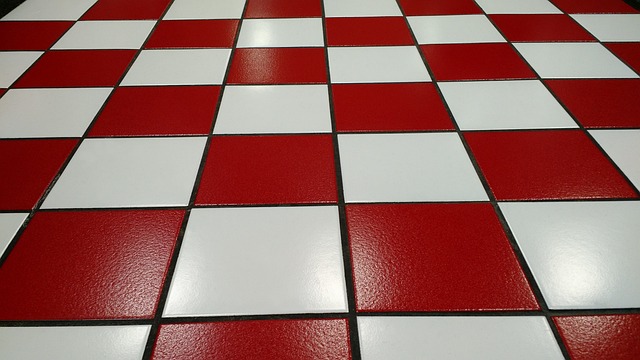Understanding grout stain causes is crucial for effective removal. Equip yourself with specialized tools, wear protective gear, and consider grout sealers for prevention. Follow a multi-step guide using natural remedies like baking soda, vinegar, or lemon juice for gentle yet powerful cleaning. For severe cases, use chemical solutions carefully, always testing first and taking safety precautions. Regular maintenance with sealing protects against future stains, while professionals handle stubborn cases, ensuring thorough cleaning and aesthetic restoration.
Tired of unsightly grout stains ruining your clean floors? This comprehensive guide is your go-to for effective grout stain removal. We demystify common causes, equip you with essential tools and natural remedies, and provide a step-by-step cleaning process. Learn about chemical solutions, prevent future stains, and know when to seek expert help. Discover fast and efficient grout stain removal techniques tailored for a sparkling home.
Understanding Grout Stain Causes

Understanding the causes of grout stains is the first step in effective grout stain removal. Grout, a material used to fill gaps between tiles, can become discolored due to various factors. One common cause is moisture penetration, leading to mold and mildew growth, especially in humid environments. Spills and splashes from liquids like coffee, wine, or even cleaning solutions can leave behind stains that, if not treated promptly, may become permanent. Additionally, certain types of tile and grout combinations are more prone to staining than others. For instance, dark-colored grouts absorb light and tend to show discoloration faster.
Regular cleaning and maintenance play a crucial role in preventing and managing grout stains. Using appropriate cleaning products and techniques can make a significant difference. Grout stain removal specialists often recommend a combination of physical scrubbing with specialized tools and chemical treatments using stain-fighting solutions. Identifying the specific type of stain is essential as different causes may require unique approaches to effective grout stain removal.
Essential Tools for Stain Removal

When tackling grout stain removal, having the right tools makes the process more efficient and effective. Some essential items on your list should include a good quality grout brush with stiff bristles designed for cleaning hard-to-reach spaces, a pressure washer (if you have access to one) for powerful deep cleaning, and a natural stone or tile-safe cleaner. Don’t forget protective gear like gloves and safety goggles to shield yourself from chemicals and debris.
Additionally, consider investing in a grout sealer to prevent future staining. After removing the existing stain, applying a sealer creates a protective barrier that repels dirt and liquid, making it easier to maintain your freshly cleaned grout lines.
Step-by-Step Guide to Cleaning Grout Stains

Removing grout stains can seem like a daunting task, but with the right approach, it’s a process that can be completed efficiently. Here’s a step-by-step guide to tackle even the most stubborn grout stains. Begin by identifying and understanding the type of stain; different substances require specific cleaning methods. Next, gather your tools: a good quality grout cleaner or a mixture of baking soda and vinegar, an old toothbrush, rubber gloves, and protective eyewear.
Protect your work area and don’t forget to test any cleaning solution in a small, inconspicuous area first. Apply the chosen cleaner to the stain, using a gentle circular motion with the toothbrush to loosen and lift dirt and grime. Let the solution sit for a few minutes, then rinse thoroughly with warm water. Repeat this process if necessary until the grout is clean and free from stains.
Natural Home Remedies for Stubborn Stains

When it comes to tackling tough grout stains, reaching for natural home remedies can be an effective and eco-friendly approach. These solutions offer a gentle yet powerful way to clean and restore your grout without harsh chemicals. Common kitchen ingredients like baking soda and vinegar are popular choices. Creating a paste from these substances and gently rubbing it onto the stained area can help lift and dissolve stubborn residue.
Another natural option is using lemon juice, known for its bleaching properties. Soaking the grout in lemon juice or applying a lemon-based cleaner can gradually fade and remove stains. Additionally, essential oils like tea tree oil possess antimicrobial properties, making them useful for disinfecting and brightening grout while leaving a fresh scent. These home remedies are cost-effective, easily accessible, and safe for use on various surfaces, providing an excellent alternative to commercial grout stain removal products.
Chemical Solutions: Effective but Cautious

Chemical solutions are often sought after for grout stain removal due to their potency and ability to tackle stubborn stains. These powerful compounds can effectively eliminate even the most ingrained grime, making them a popular choice among professionals. However, it’s crucial to exercise caution when using chemicals, as some may be harsh on both the grout and surrounding surfaces if not properly diluted or applied.
Always follow safety guidelines and use protective gear when handling chemical solutions. Test the product in an inconspicuous area first to ensure it doesn’t cause discoloration or damage. Additionally, ensure proper ventilation during application to avoid inhaling harmful fumes. With the right precautions, chemical solutions can offer fast and efficient grout stain removal for a refreshed and clean look.
Preventing Future Grout Stains

To prevent future grout stains, regular cleaning and maintenance are key. Start by wiping down grout areas with a damp cloth to remove any residual dirt or moisture immediately after cleaning. This initial step helps to disrupt the bonding of stains before they set in. Additionally, using a grout brush or steam cleaner can effectively reach tight spaces and dislodge stubborn particles.
Over time, grout can become discolored due to exposure to various substances like coffee, tea, or even soap scum. To maintain a fresh-looking grout, apply a grout sealer after cleaning. This protective layer repels liquid and prevents stains from penetrating the grout lines. Regular reapplication of sealer, especially in high-traffic areas, can significantly extend the lifespan of your grout and make future grout stain removal easier.
When to Call in the Experts

If your grout stain removal efforts have hit a rut, it might be time to consider calling in the experts. While DIY methods can be effective for minor stains and regular maintenance, more severe or persistent grout stains often require professional touch. Experts in grout stain removal possess specialized tools and knowledge that allow them to tackle tough cases effectively. They understand different grout types, their unique care requirements, and the best products to use without causing further damage.
Professional grout cleaners can also access powerful yet safe cleaning solutions designed specifically for grout. These professionals are equipped to handle delicate situations, such as stains caused by mold or mildew, hard-to-reach areas, or floors with special coatings. By leaving these tasks to experts, you ensure a thorough clean that restores your grout to its original condition, enhancing the overall aesthetic of your space.
